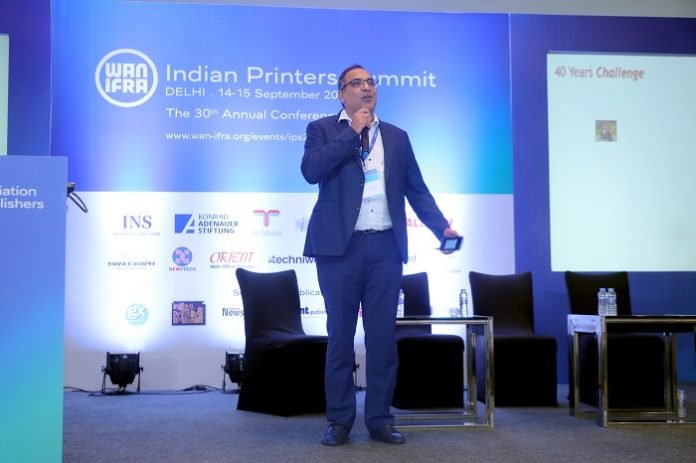Amit Khurana, the deputy CEO of Technova Imaging Systems, speaks with Indian Printer and Publisher’s senior correspondent Shardul Sharma about the cost dynamics of the newspaper industry, the potential impact of the 2024 elections on advertising revenue, investments trends, sustainability initiatives, and the digital transition.
Excerpts follow.
The recent decline in newsprint prices, following several years of high costs and supply chain challenges, is expected to aid in the recovery of the Indian newspaper industry, asserts Amit Khurana. He highlights the potential for increased advertising revenue stemming from the 2024 general elections.
“Newsprint is a significant cost factor for newspapers. Disruptions due to the pandemic and the Russia-Ukraine conflict led to record prices last year, soaring as high as US$ 1,000 per ton. However, recent months have witnessed a sharp decline in newsprint prices. This development augurs well for the newspaper industry’s overall health, potentially leading to enhanced profitability for newspaper companies in the coming years,” Khurana says.
Khurana foresees a growth in advertising revenue for Indian newspapers, albeit at a slower pace compared to the digital media sector. The advertising landscape in India, which remains under US$ 10 per capita in comparison to the nearly US$ 200 in the US, is poised for rapid expansion in alignment with the country’s growth trajectory.
“While digital media is set to flourish, print will maintain its significance due to its credibility and extensive reach. According to recent KPMG reports, the advertising market is projected to increase from Rs. 2.1 trillion to 2.8 trillion, with print witnessing gradual but consistent growth at a CAGR of 3.4%,” he says.
Khurana underscores the pivotal role of the 2023 state elections and the upcoming 2024 general elections in boosting newspaper advertising revenue, attributing the appeal of print media to its inherent credibility. Advertising categories such as FMCG, education, auto, retail, and home improvement are projected to provide continued support to the industry. Fashion, real estate, jewelry, and start-ups are poised to also contribute again to the growth of the print sector. Additionally, eCommerce enterprises will persist in utilizing print platforms to access wider audiences. Multinational corporations expanding their manufacturing and sales bases in India will find print media as a credible avenue to connect with consumers.
Khurana says that the growth outlook for the Indian economy over the next five to seven years is very robust and this will boost consumption, which means greater advertising spending by corporations. “Some reports suggest that India will be a US$ 7 trillion economy by 2030. This means there will be a strong consumption boom. Brands will spend more on advertising and newspapers too will benefit,” he says.
Navigating circulation and pagination trends
With the drop in newsprint costs and improved financial prospects for newspapers, Khurana anticipates changes in pagination trends. During periods of financial strain, many newspapers curtailed pagination to manage costs. However, the reduction in cost pressures coupled with expectations of increased advertisements may lead to a gradual recovery in pagination.
Khurana explains, “During challenging times, newspapers reduced pagination by an average of 20% to cut costs. Now, with the substantial drop in newsprint prices and in anticipation of more advertisements being carried by newspapers, I foresee a progressive increase in pagination.”
Many newspapers are claiming a return to almost 90% of pre-Covid levels. Khurana largely accepts the most optimistic claims. He accepts, however, that, “Although young readers are moving away from print, factors such as improving literacy rates, a wider reach of newsprint, the challenges posed by digital clutter, and the credibility of print media are likely to attract more readers to print,” he adds.
Investing wisely, operating brilliantly
Khurana underscores the intention of newspaper companies to invest in maintaining existing physical infrastructure, given the stable industry outlook. While significant investments in machinery may not be on the horizon, newspaper companies are likely to concentrate on ensuring sustained operational efficiency and reliability.
“As the industry outlook remains stable for the next three to five years, newspapers will allocate investments toward infrastructure maintenance. However, I don’t anticipate massive investments in machinery and infrastructure,” Khurana asserts, adding, “As India’s road infrastructure improves, travel time between cities will decrease. This is likely to prompt newspapers to rationalize their print locations. For instance, a newspaper with print facilities in both Lucknow and Kanpur may contemplate establishing a common location to serve both markets. I believe newspapers will implement such strategies to enhance operational efficiency and reduce costs.”
A hybrid print-digital experience
Speaking about the evolving digital landscape within the newspaper industry, the senior executive of the leading offset plate supplier foresees coexistence between print and digital media. “This synergy is expected to enable newspapers to access larger audiences and attain media stability. While digital platforms are set to grow at an accelerated pace, the potential for digital overload may drive a shift towards trusted mediums like printed newspapers, which offer reliable information and tangible connections to authentic journalism.”
Khurana says while Indian newspapers invested significantly in their digital ventures, monetization has been a historical challenge. “Nonetheless, digital’s recent traction suggests a promising future, even though it remains a minor segment of the overall news media business currently,” he says.
Care for climate – newspapers go green
Khurana says print media, as a responsible medium, has consistently adopted greener practices. Increasingly, newspapers are demanding environment-friendly consumables, such as plates, chemicals, and inks. He says that TechNova has been at the forefront of fostering greener solutions with newspapers using its VioGreen chemistry-free plates since 2012. Ahead of the global transition to greener alternatives, this reflects the industry’s commitment to sustainability.
Newspapers deepen connections and diversify
Khurana believes newspapers continue to explore various digital printing solutions as they shift from a scale-oriented to a scope-oriented model. Digital media and digital print present multi-channel or hybrid opportunities to advertisers’ and readers’ niche requirements through customization and personalization, enhancing overall engagement.
“Globally, many newspapers have adopted digital printing machines as complementary tools to conduct campaigns, embrace hyperlocal approaches and deliver higher value by addressing specific market needs. Another observed trend is diversification into the packaging industry, leveraging existing resources, land, machinery, brand value, and other strengths to tap into the burgeoning Rs. 60,000 crore packaging industry in India, which is experiencing rapid expansion,” Khurana says.


















